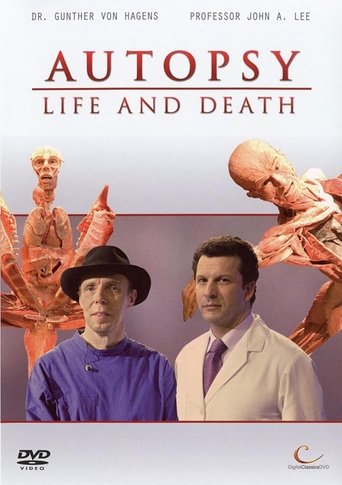










Cancer (Lesson #2: Tumours)
In the second programme of the series von Hagens and Lee take a look at cancer. They illuminate the difficulties of diagnosing and treating a disease that is a result of the body's own cells multiplying uncontrollably. Von Hagens dissects a woman who died of bowel cancer to reveal the site of the primary tumour and the other parts of her body that it affected. He also reveals the silent spread of tumours in the frozen body of a woman who died from breast cancer.
Country: GB
Language: En
Runtime: 60
Season 1:

The series begins by looking at diseases affecting the circulatory system, a major cause of death in the UK. Von Hagens and Lee explain that rather than life hanging by a thread, it hangs by a tube. In particular they demonstrate the complex network of blood vessels that deliver oxygen to our vital organs. If some of these narrow, harden, become blocked or burst, they can damage the heart and end in what we understand as a heart attack.

In the second programme of the series von Hagens and Lee take a look at cancer. They illuminate the difficulties of diagnosing and treating a disease that is a result of the body's own cells multiplying uncontrollably. Von Hagens dissects a woman who died of bowel cancer to reveal the site of the primary tumour and the other parts of her body that it affected. He also reveals the silent spread of tumours in the frozen body of a woman who died from breast cancer.

When von Hagens and Lee address the subject of poisoning, they are not thinking of a murder mystery. Von Hagens dissects the body of a dialysis patient who died of kidney failure to reveal that we are more likely to die of internal poisoning than by a surreptitious dose of arsenic. Lee explains how the body can be contaminated if critical organs like the kidneys and liver malfunction and fail to filter out poisonous byproducts of metabolism.

In the last programme, von Hagens and Lee illustrate the process of ageing. To reveal the dread process for us all to see, the two scientists compare the bodies of two live models - an 84-year-old and a 24-year-old. Von Hagens then compares sections from the cadaver of a woman over 80 years old with the same sections from a much younger woman. By revealing the internal extent of ageing damage, von Hagens and Lee demonstrate the widespread effects of ageing and explain why we can't life forever.


